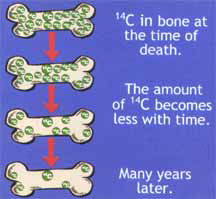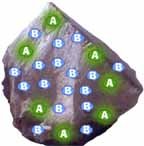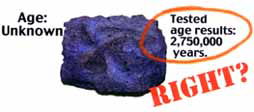Answers For Kids: Dating Methods
Originally published in Creation 24, no 3 (June 2002): 34-37.
It’s important that we allow God’s written record of history, the Bible, to guide our thinking about the past—this includes our understanding of the age of the Earth/universe and the fossils.
Dating Methods
How many times have you heard something like, “This animal lived 50,000 years ago”, or “This person died 20,000 years ago’? Have you ever wondered how the scientists knew the age of the bone? After all, the scientists haven’t been around that long, have they?
There are a variety of different ways to figure out how old an object is.
Of course, the best method is to check the account of a reliable eyewitness, if one is available. The Bible is such a record. Since it is the written Word of God, we can trust it to tell us the truth about the past. Carefully studying the Biblical record, we find that the universe has an age of around 6,000 years, and that a world-changing, global Flood occurred about 4,300 years ago.
Those who don’t accept the Biblical account of history look for other ways to discover the age of things. One of these methods is based on a substance found in our bodies, plants and all living things—it’s called carbon.
How Carbon Dating Works

Click above for full size illustration of the carbon cycle
There are two basic forms of carbon: one that occurs naturally, called carbon-12 (12C), and one that forms from processes acting on nitrogen in the atmosphere, called carbon-14 (14C). Both of these combine with oxygen to form carbon dioxide (CO2), which we breathe out and plants take in. When a cow eats grass, its body absorbs the carbon (both 12C and 14C) in the plant.

When the cow dies, it stops taking in carbon (for obvious reasons). The amount of 12C in the cow’s body stays the same after death, but the amount of 14C changes because it returns to nitrogen.
As time goes on, the amount of 14C continues to decrease until nothing is left, which is supposedly about 50,000 years later.
When a paleontologist finds a bone (or a piece of wood), she can measure the amount of 14C and 12C it contains. Based on how much 14C is left, she can supposedly calculate when the animal (or plant) died.
Sounds like a good idea, doesn’t it? But there’s a problem.
The Problems is …
There are many factors that affect how much 14C an animal (or a person or plant) has in it when it dies. This changes how long ago the animal appears to have died.
For instance, plants don’t take in as much 14C as scientists expect. So, after they die, there is less 14C in the plants to change back to nitrogen. This makes the plant appear to have died many more years ago than it actually did (for example, the plant might appear to be, say, 3,000 years old, rather than 2,000).

Also, the amounts of 14C and 12C in the atmosphere haven’t been constant throughout history (for instance, Noah’s Flood lowered the total amount of available carbon by burying lots of animals and plants). So something that lived (and died) when the proportion of 14C was less than normal would appear to have died more years ago than it actually did (for example, it might give an age of 3,000 years before the present, rather than its true age of 2,000 years).
Even many archaeologists don’t think “carbon dating” is completely accurate all the time.
When these (and other) problems are then taken into account, a scientist can interpret the result of the carbon dating within a Biblical timeframe, but even so, these results can not be used to prove the age of once-living things.
How to Find a “Date”
Most people think that scientists can actually measure the ages of rocks, using a method called “radiometric” or “radioisotope” dating. More often, rocks are “dated” by the fossils they contain, based on a pre-existing belief in evolution. But even radiometric dating does not actually directly measure the age of something (there is no substance called “age”). It measures the amounts of certain radioactive substances. This information then has to be interpreted, based on certain beliefs.
In fact, most fossils do not even contain radioactive minerals. So if scientists wanted to measure the age of a fossil using this method, they would look for a nearby layer of igneous rock (e.g. rock that forms from lava from a volcanic eruption)—perhaps in the rock layers above where the fossil was found, or in the layers below. When they find one, they gather a sample of the hardened lava and send it off to a laboratory to test it for radioactive elements.
The idea behind radiometric dating goes like this (hang on—this gets a bit technical, but we’re sure you’ll get it!):
When a volcano erupts, hot, molten rock (called “lava”) from deep inside the Earth is released. This lava is made of various elements. Elements are the “building-blocks” of the universe (for example, water is made from the elements hydrogen and oxygen).
Some elements (we’ll call them “A”) in the lava are radioactive, which means that they change into other elements (we’ll call these “B”).


This is often very slow, so that it would take millions (for some elements, billions) of years, starting with a lump of A, for half of it to change into B (the “half life”).

However, even if we measured how much of A and B were in a sample of rock, could we figure out how long A has been changing into B, and therefore how old the rock is? No! We don’t know what the rock was like when it formed, or what has happened to it since. We weren’t there.
But is it a Good Date?

This rock seems REALLY, REALLY OLD!
The scientists who interpret these amounts of A and B to conclude that millions of years have passed must first assume three main things about the rock:
- How much A and B was in the rock when it hardened.
- A has decayed into B at the same rate over the years.
- The amount of A or B in the rock has not increased or decreased in any other way.
But because we haven’t been able to study all the rocks everywhere all the time, it’s impossible for us to know:
- If B was in the rock before it hardened.
- If A has always decayed at the same rate.
- If water, for instance, has removed some A, or carried some B into the rock from elsewhere.
All of these factors will affect how “old” the rock appears—in practice, usually making it appear a lot older than it really is.
To test this method, some scientists gathered samples from hardened lava at Mount St Helens, which erupted most recently in the early 1980s. The samples, which came from rocks that formed between 1980 and 1986, were sent to a lab and were “dated” using the potassium-argon (K-Ar) method. The test results ranged from between 340,000 to 2.8 million years old!
Other scientists collected samples from cooled lava flows from Mt Ngauruhoe, in New Zealand. These rocks are known to be less than 50 years old, because people observed the volcano erupting in 1949, 1954 and 1975. But the lab results indicated that the rocks were up to 3.5 million years old!


If this method doesn’t work on rocks the ages of which we know, how can we trust it to work on rocks of unknown age?
After examining the assumptions behind this “dating method”, and doing scientific experiments to see if this method works on rocks of an already known age, we find that “radiometric dating” isn’t all it’s cracked up to be. (Actually, any process used to find ages for things is based on assumptions, and so is not reliable.)
It’s important that we allow God’s written record of history, the Bible, to guide our thinking about the past—this includes our understanding of the age of the Earth/universe and the age of fossils.
None
BrowseRecommended Resources
- © 2025 Answers in Genesis
- Privacy Policy
- Contact
- About


